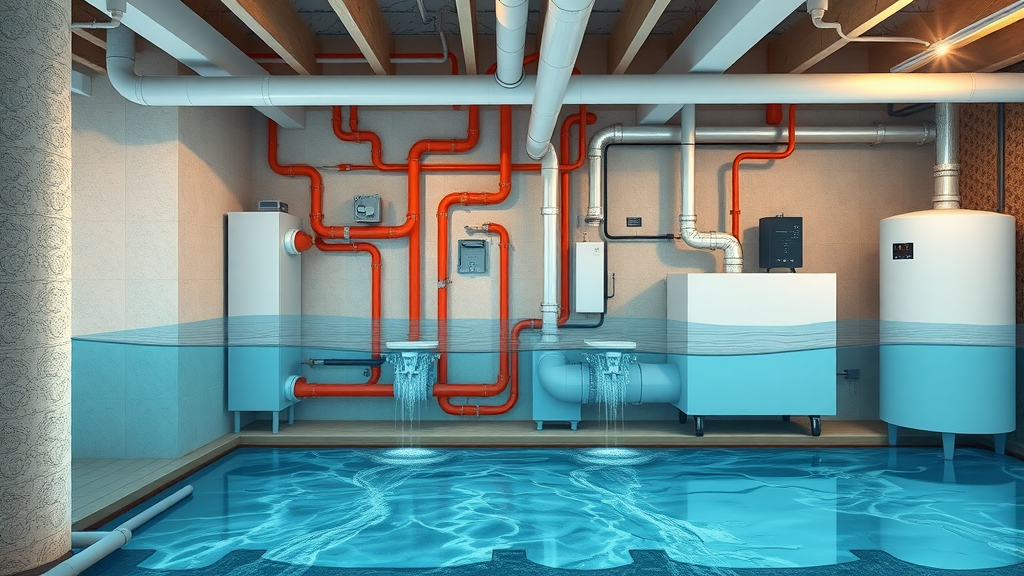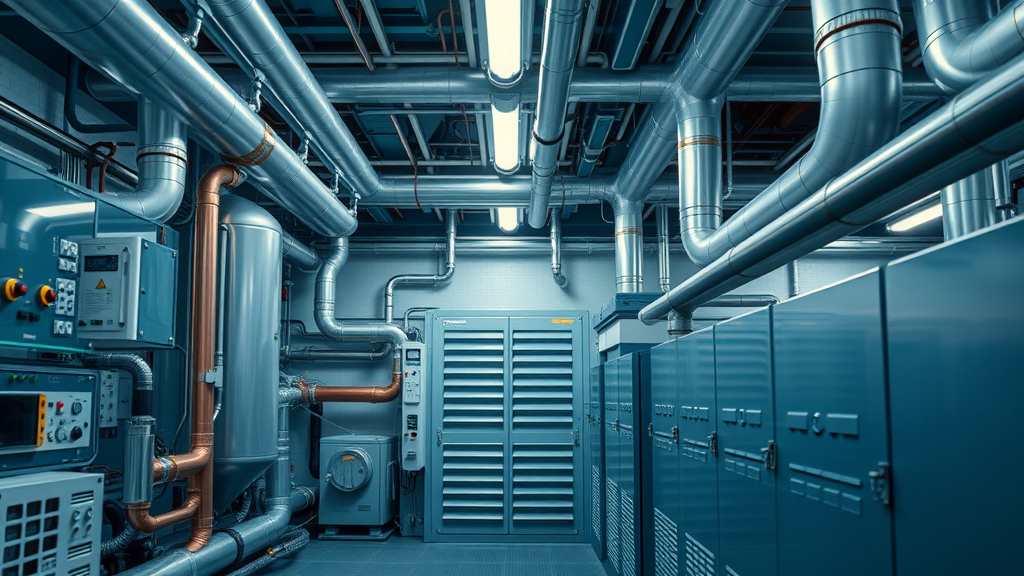Hook: Did you know that buildings account for almost 40% of global energy consumption? This makes it more important than ever for businesses to invest in efficient heating solutions like hydronic underfloor heating. If you’re a commercial property owner looking for ways to cut costs, improve comfort, and boost sustainability, this guide reveals why hydronic underfloor heating could be the performance upgrade your business has been searching for.
Why Commercial Properties Are Turning to Hydronic Underfloor Heating
Did you know? Buildings account for almost 40% of global energy consumption, making efficient heating solutions crucial for businesses.
For commercial property owners and their advisors, energy efficiency and occupant comfort are increasingly competitive advantages. Today, savvy businesses are moving away from traditional radiators and ducted systems, instead opting for hydronic underfloor heating. By circulating warm water beneath the floor, these systems deliver even, gentle heat throughout large spaces—without the hot spots or cold drafts common in older heating systems. This innovation isn’t just about better comfort; it also offers significant reductions in running costs and carbon emissions.
With energy bills on the rise and sustainability mandates closing in, many commercial properties are embracing hydronic underfloor heating systems as a future-proof investment. These systems work quietly, remain invisible, and integrate seamlessly into a wide range of modern and heritage buildings. If you manage offices, retail spaces, hospitality venues, or healthcare facilities, switching to underfloor heating can help position your property as a leader in both comfort and corporate responsibility.

What You’ll Learn About Hydronic Underfloor Heating Systems
- Key advantages of hydronic underfloor heating for businesses
- How floor heating systems compare with traditional heating systems
- Expert insights into installation, costs, and maintenance
- Common myths and misconceptions clarified
- Practical advice for choosing the right heating system for your property
Understanding How Hydronic Underfloor Heating Works
Hydronic Underfloor Heating System: The Science Behind the Comfort
At its core, a hydronic underfloor heating system consists of a network of strong, flexible pipes laid beneath the floor surface. Warm water is circulated through these pipes, typically heated by a modern boiler or a renewable energy source such as a heat pump. The system gently radiates heat upward, evenly warming both the floor and the air above. Unlike conventional heating systems—often relying on forced air or hot radiators—hydronic systems eliminate cold spots and create a comfortable, uniform temperature throughout the entire room. Plus, since the warmth is delivered directly beneath the floor, there’s minimal heat loss and improved efficiency compared to older heating technologies.
Hydronic underfloor heating is suitable for a wide range of commercial applications. Whether you have open-plan offices, retail environments with heavy foot traffic, or large hospitality venues, the system's smart zoning capabilities allow for custom climate control across different areas. This means tailored comfort for staff and visitors—even during cold UK winters. As the demand for sustainable heating solutions rises, businesses are turning to underfloor heating for its blend of cutting-edge comfort, reliability, and energy savings.
When considering installation, it's important to be aware of common pitfalls that can impact system performance. For a practical overview of mistakes to avoid and tips for a smooth project, you may find this guide on choosing underfloor heating systems and avoiding common errors especially useful as you plan your upgrade.

Comparing Hydronic System and Electric System Technology
Both hydronic underfloor heating and electric underfloor heating systems provide comfortable floor warming, but they use different technologies and offer unique advantages. Electric systems rely on heating cables or mats embedded directly beneath the floor finish. They heat up relatively quickly and are often easier to install in smaller spaces or renovations where existing floor heights must be preserved. While electric underfloor heating systems are popular for residential bathrooms or single rooms, their operation can become costly at the scale required for larger commercial properties due to higher ongoing energy demands.
In contrast, hydronic systems are powered by a gas boiler, heat pump, or solar thermal array, circulating warm water to efficiently heat large spaces. Hydronic underfloor heating excels in commercial and multi-zone environments because it delivers lower running costs, improved energy efficiency, and compatibility with eco-friendly energy sources. Plus, with proper floor insulation and professional installation, the system minimizes heat loss for top-tier performance. When deciding between hydronic or electric underfloor heating for your business, consider both the scale of your application and future operational savings.
Key Benefits of Hydronic Underfloor Heating for Businesses
- Improved energy efficiency compared to traditional heating systems
- Enhanced comfort and uniform heat distribution
- Reduced carbon footprint
- Seamless integration with modern and classic architecture
- Quiet, invisible, and maintenance-friendly operation
One of the standout features of hydronic underfloor heating is that it combats many of the biggest challenges faced by commercial property operators—rising energy costs, high carbon emissions, and occupant discomfort. By delivering steady, radiant warmth from beneath the floor, these systems use far less energy compared to traditional radiators or forced-air heating solutions. This translates into measurable reductions in both gas and electricity bills, lower carbon output, and eligibility for green building certifications or incentives. Businesses that invest in energy-efficient heating systems often find their properties more attractive to high-quality tenants, clients, and employees.
Beyond the measurable stuff, comfort really counts. The even, gentle heat of underfloor systems means no more cold feet, chilly corners, or overheating near radiators. It’s also completely silent and invisible, which enables flexible interior design. Because the pipes are protected beneath the floor, maintenance is rarely needed—a major win in busy environments where downtime costs you money. As cities evolve and new buildings embrace floor heating systems as standard, you can expect to see hydronic technology becoming the gold standard for commercial heating and even cooling innovation.

| Feature | Hydronic Underfloor Heating | Traditional Heating (Radiators/Forced Air) |
|---|---|---|
| Energy Efficiency | High – Suitable with heat pumps and renewable energy | Moderate – Increased heat loss, less suited to renewables |
| Operational Cost | Low | Medium to High |
| Comfort/Heat Distribution | Consistent, even warmth throughout | Uneven, with hot/cold spots |
| Maintenance | Minimal; long life expectancy | Moderate; regular servicing required |
| Design Integration | Invisible, more flexible layouts | Visible, restricts placement of furniture |
Hydronic Underfloor Heating vs Electric Underfloor Heating: Which Is Best for Commercial Spaces?
When choosing a floor heating system for a commercial environment, the two primary contenders are hydronic underfloor heating systems and electric underfloor heating systems. Each offers different installation processes, operational characteristics, and best-fit scenarios. Generally, hydronic systems are recommended for larger spaces—such as open-plan offices, hospitality venues, healthcare facilities, and schools—due to their capacity for zoning and cost-effective heating across wide areas. They work exceptionally well with modern heat pumps, future-proofing your building for sustainable heating and cooling demands.
Conversely, electric underfloor heating can be attractive for small areas or retrofits, where quick installation and a lower upfront investment are priorities. However, when scaled up, their higher per-kilowatt running cost and reliance on grid electricity can make them less suitable for commercial use. The decision may boil down to your business’s size, usage patterns, and whether you’re planning a new build or upgrading an existing property. Consulting with underfloor heating experts helps ensure you choose the best technology for long-term savings and comfort.
| System Type | Pros | Cons |
|---|---|---|
| Hydronic Underfloor Heating |
|
|
| Electric Underfloor Heating |
|
|
Integrating Hydronic Underfloor Heating with Modern Heating and Cooling Systems
Seamless Heating and Cooling for All-Year-Comfort
A key advantage of today’s hydronic underfloor heating systems is their ability to integrate with advanced heating and cooling technologies. Modern solutions pair underfloor heating with efficient heat pumps or geothermal systems, enabling year-round thermal comfort. In winter, warm water gently circulates through the floor, heating every corner. During summer, innovative systems can reverse the process, circulating cooler water to lower indoor temperatures, effectively turning your floor into a radiant cooling system. This dual-purpose approach, sometimes called “radiant heating and cooling,” delivers unmatched comfort and energy savings from a single invisible installation.
Integration is seamless for both new buildings and major refurbishments. With smart controls and zoning, facilities managers can tailor temperatures for each area or time of day. That means your business can reduce energy waste, enhance occupant wellness, and meet evolving environmental requirements faster. Most importantly, choosing hydronic systems today gives your property future flexibility, allowing you to respond to both client needs and regulatory changes with ease.

Installation Process: What Businesses Need to Know About Hydronic Underfloor Heating Systems
- Site survey and suitability assessment: A professional team evaluates your premises, measuring and identifying existing infrastructure to ensure compatibility with a hydronic underfloor heating system.
- System design and zoning: Engineers create a tailored plan, segmenting areas as needed (e.g., open-plan workspaces, meeting rooms, entrances) for optimal comfort and energy savings.
- Pipe installation and floor layering: Installers lay out high-quality piping across each zone, then add insulation and floor surfacing materials to maximize efficiency and protect the pipes.
- Connection to heat source (boilers, heat pumps): The pipe network is connected to your chosen central heat source, optimising integration for reliability and low emissions.
- System testing and commissioning: Once all connections are made, technicians rigorously test and commission the system, ensuring perfect operation and providing handover training for your facilities team.
“Quality installation is key to maximising the performance and lifespan of your hydronic underfloor heating system.” – Peak Underfloor Heating Ltd Consultant

Cost Analysis: Is Hydronic Underfloor Heating Worth It for Your Business?
Upfront Investment vs Long-Term Savings
One of the most common questions from commercial property owners is about the cost-effectiveness of hydronic underfloor heating. While the initial investment can be higher than standard radiator or electric underfloor heating, the running and maintenance costs are significantly lower—especially when heating large spaces over long periods. Hydronic systems also boost your green credentials, helping attract tenants and clients who value sustainable operations.
In practice, the real value comes through energy savings, improved building value, and reduced maintenance overhead. A professionally installed hydronic underfloor heating system will last decades, offering a fast return on investment. It’s an investment in both immediate comfort and your building’s future marketability.
| Property Type/Size | Hydronic Underfloor Heating | Electric Underfloor Heating | Traditional Radiators |
|---|---|---|---|
| Small Retail Unit (100m²) | £8,000–£13,000 | £4,000–£8,500 | £3,000–£5,000 |
| Open Plan Office (500m²) | £30,000–£45,000 | £16,000–£28,000 | £15,000–£22,000 |
| Large Venue (1,000m²+) | £58,000–£95,000 | £32,000–£55,000 | £28,000–£40,000 |

Addressing Common Concerns About Hydronic Underfloor Heating Systems
- Heating response times: Advanced designs offer rapid heat-up for minimal waiting, even in older buildings.
- Compatibility with different floor coverings: Suitable with a wide range of carpets, tiles, wood, and more.
- Maintenance requirements: Modern hydronic systems require minimal routine maintenance, typically only annual checks.
- Integration with existing heating systems: Can be combined with radiators, heat pumps, or other systems for tailored solutions.
“Advancements in hydronic system design now offer faster warm-up times and increased efficiency, even for legacy buildings.”
Today’s hydronic underfloor heating solutions are engineered for modern business realities. Fast warm-up, compatibility with many popular floor finishes, robust integration with smart building controls, and low ongoing maintenance make the technology suited even for legacy buildings. By working with experienced installers, business owners can resolve most historic concerns and trust that their system will run efficiently for decades.
Integration with renewable energy sources such as heat pumps further futureproofs your property. Whether you’re renovating, extending, or planning a new development entirely, there is a hydronic floor heating system designed to suit your needs.
People Also Ask: Hydronic Floor Heating FAQs
What are the disadvantages of a hydronic floor heating system?
The main disadvantages are the higher initial installation cost compared to traditional or electric systems, and the need for experienced, professional installation. System retrofitting in older properties may require adjustments to floor height. However, long-term energy savings, comfort, and low maintenance often outweigh these factors for commercial property owners.
Is hydronic floor heating worth it?
For most commercial spaces, yes—hydronic underfloor heating offers superior energy efficiency, consistent comfort, and lower running costs over time. Its value grows in larger, frequently used spaces where energy savings quickly add up. Also, integration with renewables and low maintenance makes it a future-ready solution for responsible businesses.
Does hydronic heating use a lot of electricity?
Hydronic underfloor heating primarily uses energy to heat water via a boiler or heat pump. When paired with a high-efficiency heat pump or renewable energy, the system’s electricity usage is far less than electric underfloor heating, especially for large spaces. Most commercial installations see significant energy savings compared to traditional systems.
How much does it cost to install hydronic floor heating?
Installation costs vary by location, building type, system design, and heat source, but businesses can expect to pay from £80 to £90 per square metre for new builds, with refurbishment projects possibly costing more due to additional preparation work. For an exact quote tailored to your premises, it’s always best to contact an expert installer.
FAQs: Hydronic Underfloor Heating for Businesses
- Can hydronic systems be retrofitted into existing properties? Yes—with careful planning, hydronic systems can be installed in most commercial properties, though floor heights may require adjustment.
- How long do hydronic underfloor heating systems last? These systems often last 30 years or more with minimal maintenance.
- What maintenance is required for commercial hydronic underfloor heating? Regular annual checks and standard boiler or heat pump maintenance keep the system running efficiently.
- What floor finishes are suitable for hydronic underfloor heating installations? Most modern and natural floor finishes, including tile, wood, and carpet, are compatible, provided they have appropriate thermal properties.
Key Takeaways: Why Invest in Hydronic Underfloor Heating?
- Hydronic underfloor heating delivers superior comfort and energy savings for commercial properties
- Lower running costs and maintenance make it ideal for business longevity
- Flexible system design allows integration with heating and cooling sources
- Adds value and appeal to any business environment
Conclusion: Take the Next Step with an Expert Hydronic Underfloor Heating Consultation
Ready to improve your property? It can be difficult to know exactly what system is best for your application so if you are still unsure please feel free to contact us and one of our consultant’s will be happy to discuss your exact requirement’s. Call 01246 387120, or Email us at info@peakunderfloorheating.com.
If you’re eager to deepen your understanding of how hydronic underfloor heating can transform comfort and efficiency in both commercial and residential settings, explore our comprehensive article on unlocking effortless comfort with hydronic underfloor heating. Discover advanced strategies, real-world applications, and expert insights that can help you make the most informed decision for your next project. Taking this next step could be the key to maximising both energy savings and occupant satisfaction in your business environment.
Sources
- Carbon Trust – https://www.carbontrust.com/resources/buildings-40-percent-of-global-energy-use
- Energy.gov – https://www.energy.gov/energysaver/radiant-floor-heating
- CIBSE Knowledge Portal – https://www.cibse.org/knowledge/knowledge-items/detail?id=a0q3Y00000HzmPbQAJ
- Peak Underfloor Heating Ltd – https://www.peakunderfloorheating.com/
Hydronic underfloor heating offers numerous advantages for commercial properties, including enhanced energy efficiency, consistent heat distribution, and improved indoor air quality. For a comprehensive understanding of these benefits, consider reading “All About Hydronic Radiant Floor Heating” by Ecohome, which delves into the system’s operation and its impact on comfort and performance. (ecohome.net) Additionally, “Hydronic Underfloor Heating” by Danfoss provides insights into the components and controls essential for optimizing such systems. (danfoss.com) Exploring these resources will equip you with the knowledge to make informed decisions about integrating hydronic underfloor heating into your business premises.
 Add Row
Add Row  Add
Add 









Write A Comment